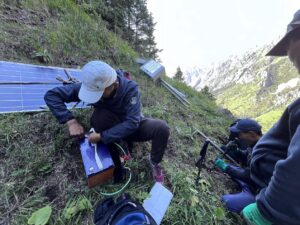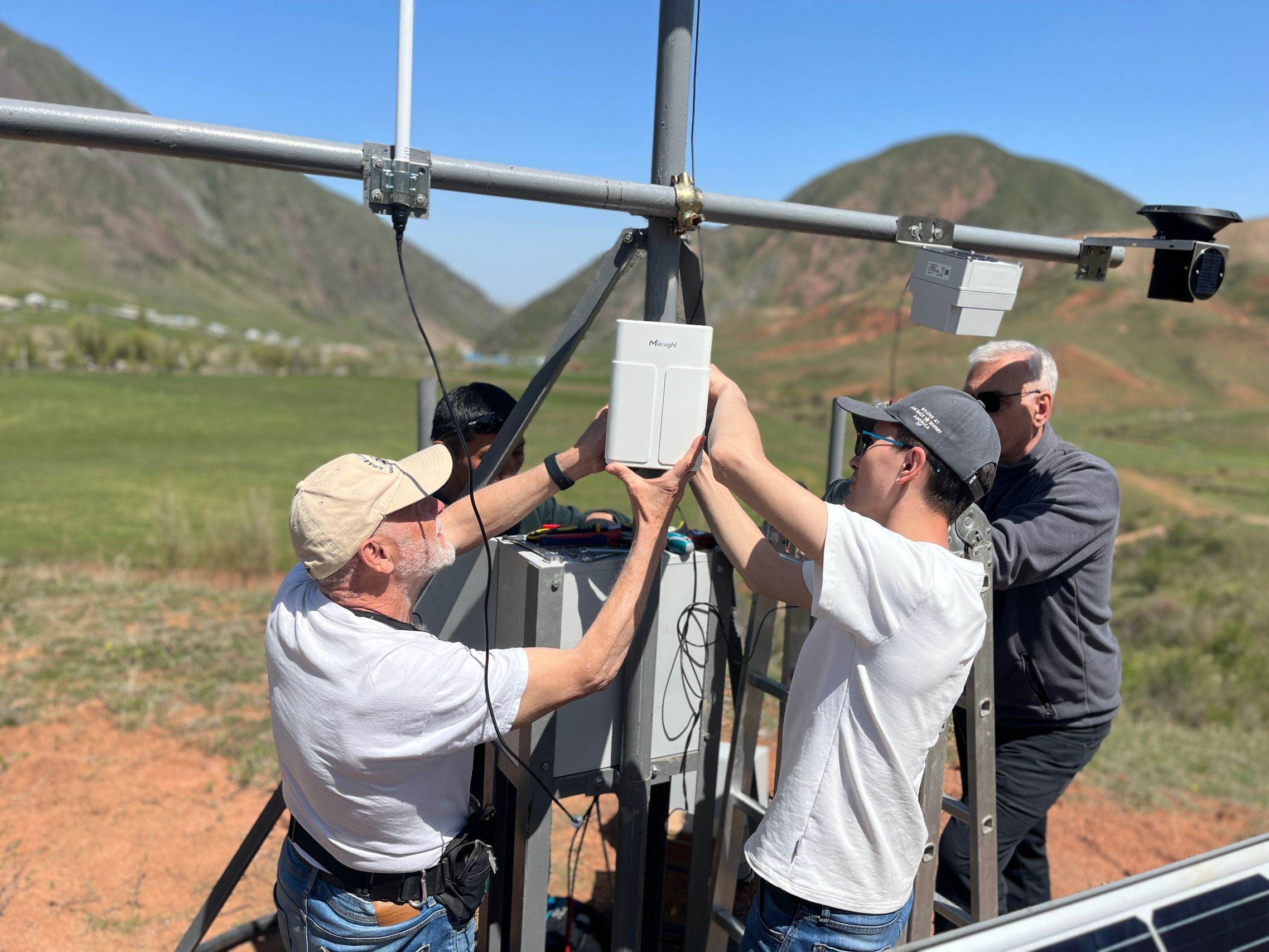27 апреля 2023 года группа, состоящая из представителей кыргызского отделения Айсок, МЦТФ и ЦАИИЗ, успешно установила и запустила датчики с поддержкой Lorawan на оползне Татыр.
Татырский оползень географически расположен в 30-40 км к югу от Бишкека. В административном отношении район входит в состав Арашанского аильного округа Аламединского района. Сформировавшись на северном склоне, оползень простирается на 1510 м, имеет ширину от 250 до 300 м и мощность от 10 до 15 м. В оползне участвуют суглинистые почвы, охватывающие подстилающие породы палеоген-неогенового возраста. Его образование в первую очередь связано с аномальными атмосферными осадками в сочетании с воздействием подземных вод, выходящих в виде родников, и ближайшим тектоническим разломом. Последняя значительная активность была зарегистрирована в 2004 году, когда оползень сместился на 70 метров после года сильных дождей. Оползень проходит по пути к популярным местам катания на лыжах и туристическим направлениям. Раньше мониторинг осуществлялся вручную посредством периодических выездов на места. Близость объекта к городу Бишкек сделала его идеальным экспериментальным местом для этого исследовательского проекта, что позволило быстро выполнить калибровку датчиков и подтвердить цели исследования.
Болот Молдобеков, руководитель ЦАИИЗ, представил обзор оползня, обсудив его особенности, историческую подоплеку и предложив практические рекомендации по установке датчиков для сбора точных данных. Эрманно Пьеросемоли из ICTP обучил команду установке шлюзов Lorawan, антенн, калибровке сигналов, обновлению прошивки и подключению датчиков через частоты Lorawan. Марко Зеннаро помог установить программное обеспечение для мониторинга, проведя практическую демонстрацию работы MQTT и обеспечив безопасную передачу данных на серверы по каналам VPN. Все члены бригады участвовали в установке мачт, оборудования, датчиков и создании защитного периметра вокруг площадки.
Установка датчика направлена на практическое тестирование и проверку технологии Lorawan, датчиков и возможностей решений с открытым исходным кодом. Ожидается, что оборудование будет автоматически генерировать данные через Lorawan и передавать их на серверы, что принесет пользу ключевым заинтересованным сторонам и местным сообществам. Кроме того, данные будут визуализированы в удобном для пользователя формате, что позволит заинтересованным сторонам эффективно понять и оценить текущую ситуацию.
Дополнительная информация по Татырскому оползню: Активное смещение 70-метрового склона, зафиксированное в мае 2004 г., произошло всего через год после обильного 2002 г., вызвавшего массовые оползни предгорья и некоторых горных склонов. Это говорит о том, что основание оползня пропитано грунтовыми водами из глубоких трещиноватых зон, для циркуляции которых требуется значительное время. При этом Татырский оползень относится к глубинным оползням, охватывая в своем движении значительную глубину склоновых отложений. Оползни такого типа известны длительным периодом (30-50 лет) стабильности.
Татырский оползень географически расположен в 30-40 км к югу от Бишкека. В административном отношении район входит в состав Арашанского аильного округа Аламединского района. Сформировавшись на северном склоне, оползень простирается на 1510 м, имеет ширину от 250 до 300 м и мощность от 10 до 15 м. В оползне участвуют суглинистые почвы, охватывающие подстилающие породы палеоген-неогенового возраста. Его образование в первую очередь связано с аномальными атмосферными осадками в сочетании с воздействием подземных вод, выходящих в виде родников, и ближайшим тектоническим разломом. Последняя значительная активность была зарегистрирована в 2004 году, когда оползень сместился на 70 метров после года сильных дождей. Оползень проходит по пути к популярным местам катания на лыжах и туристическим направлениям. Раньше мониторинг осуществлялся вручную посредством периодических выездов на места. Близость объекта к городу Бишкек сделала его идеальным экспериментальным местом для этого исследовательского проекта, что позволило быстро выполнить калибровку датчиков и подтвердить цели исследования.
Болот Молдобеков, руководитель ЦАИИЗ, представил обзор оползня, обсудив его особенности, историческую подоплеку и предложив практические рекомендации по установке датчиков для сбора точных данных. Эрманно Пьеросемоли из ICTP обучил команду установке шлюзов Lorawan, антенн, калибровке сигналов, обновлению прошивки и подключению датчиков через частоты Lorawan. Марко Зеннаро помог установить программное обеспечение для мониторинга, проведя практическую демонстрацию работы MQTT и обеспечив безопасную передачу данных на серверы по каналам VPN. Все члены бригады участвовали в установке мачт, оборудования, датчиков и создании защитного периметра вокруг площадки.
Установка датчика направлена на практическое тестирование и проверку технологии Lorawan, датчиков и возможностей решений с открытым исходным кодом. Ожидается, что оборудование будет автоматически генерировать данные через Lorawan и передавать их на серверы, что принесет пользу ключевым заинтересованным сторонам и местным сообществам. Кроме того, данные будут визуализированы в удобном для пользователя формате, что позволит заинтересованным сторонам эффективно понять и оценить текущую ситуацию.
Дополнительная информация по Татырскому оползню: Активное смещение 70-метрового склона, зафиксированное в мае 2004 г., произошло всего через год после обильного 2002 г., вызвавшего массовые оползни предгорья и некоторых горных склонов. Это говорит о том, что основание оползня пропитано грунтовыми водами из глубоких трещиноватых зон, для циркуляции которых требуется значительное время. При этом Татырский оползень относится к глубинным оползням, охватывая в своем движении значительную глубину склоновых отложений. Оползни такого типа известны длительным периодом (30-50 лет) стабильности.

Field notes challenges on installation of gateways in mountainous areas
August 25, 2025
No Comments
Climbing 700 meters with a 55° slope with solar panels, heavy batteries, and an IoT communication gateway strapped to our backs is not the usual

From Mountains to Data – Insights from RIPE 89
November 5, 2024
No Comments
The RIPE 89 Meeting, held in Prague, brought together a vibrant mix of technology enthusiasts and industry experts to share knowledge on data, networking, and

From Mountains to Data Low-Cost Weather Stations in Kyrgyzstan’s Challenging Terrain
June 27, 2024
No Comments
On behalf of the research team, I am very pleased to announce that our preprint of a research paper on the use of low-cost automatic


